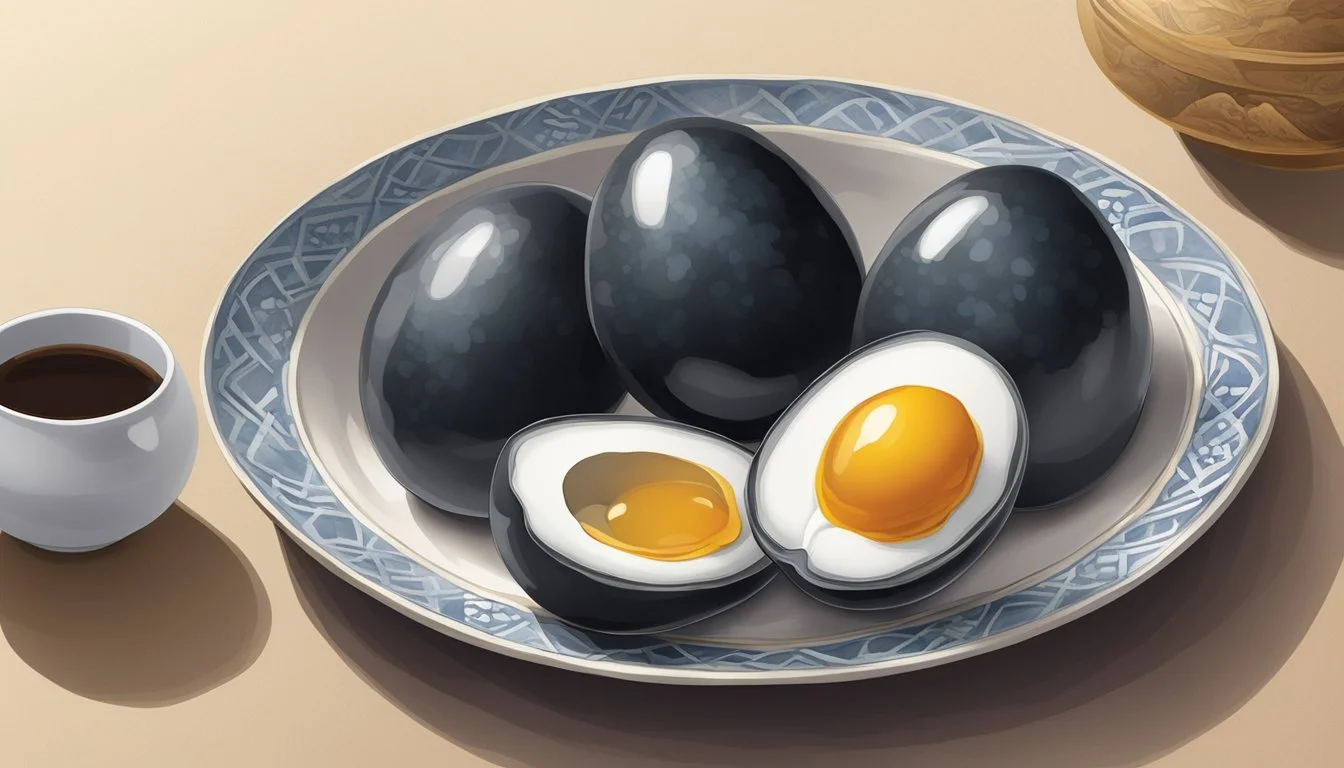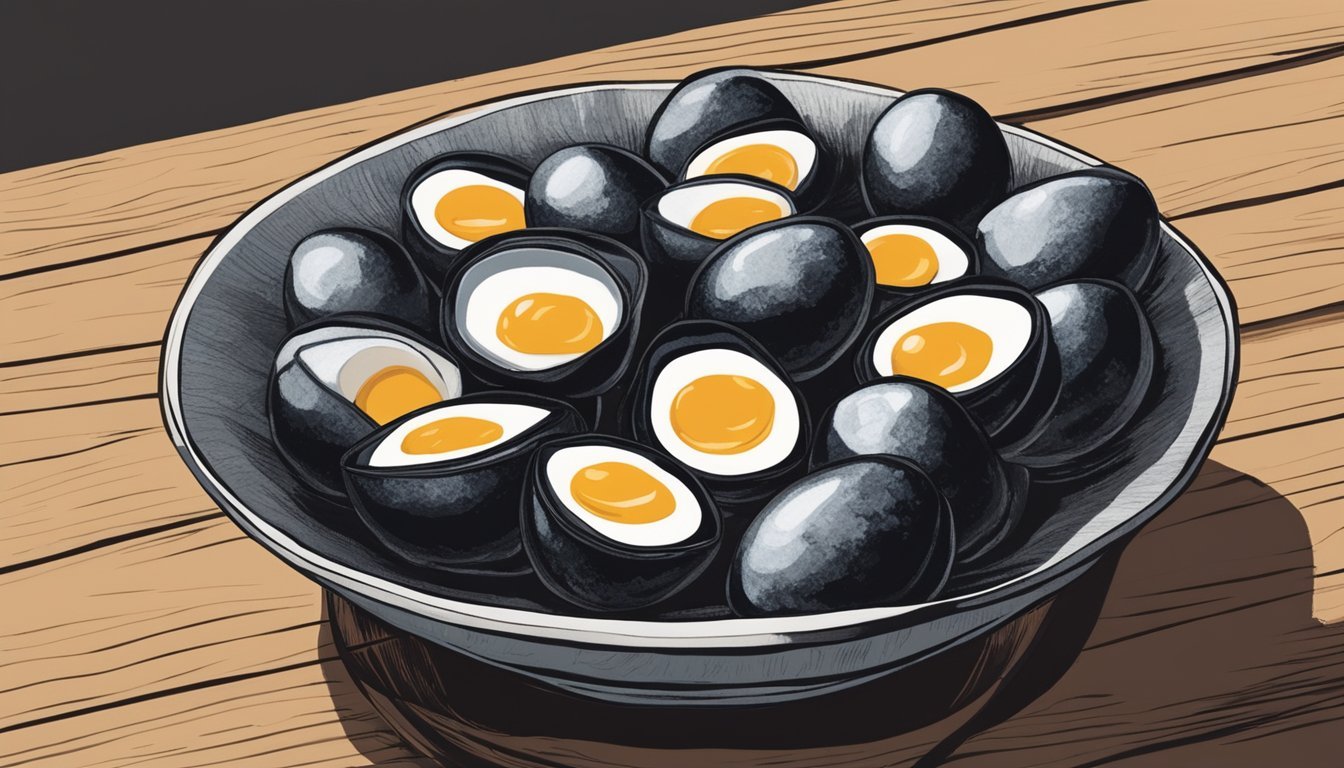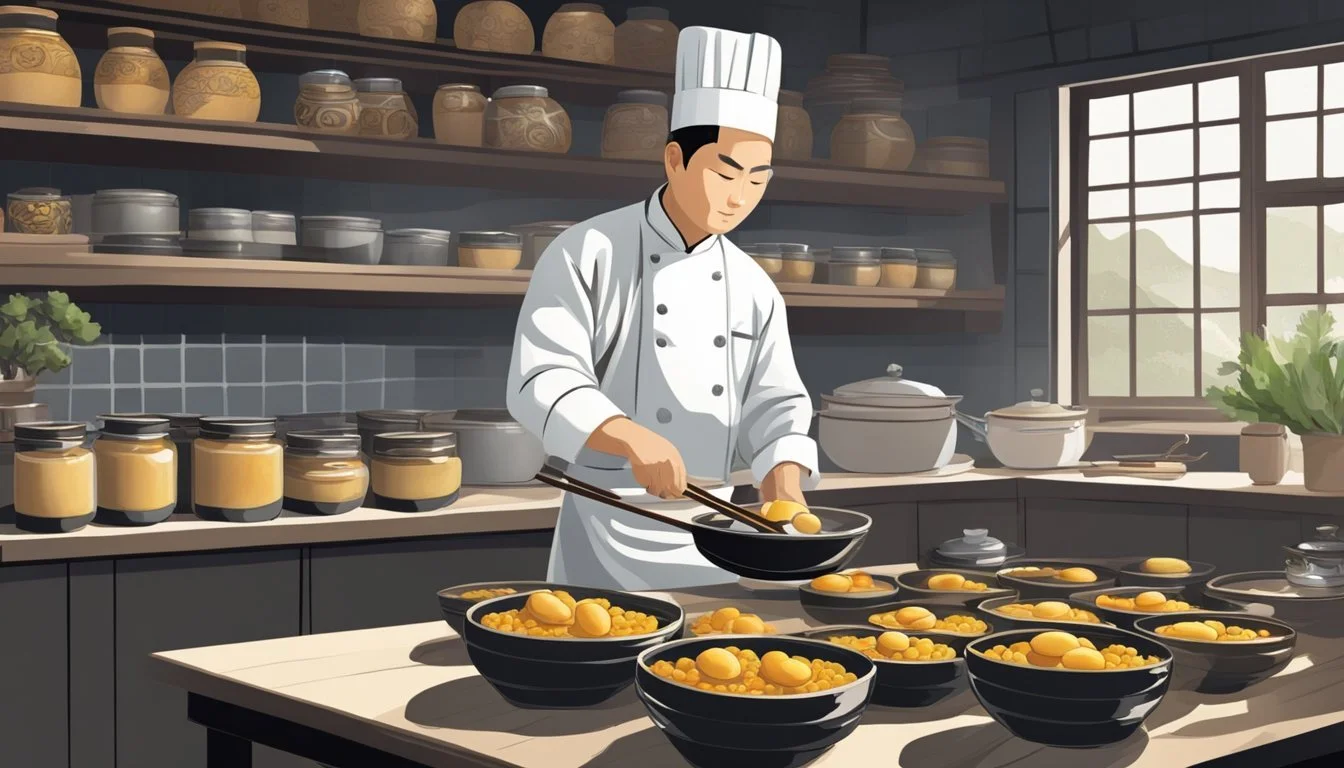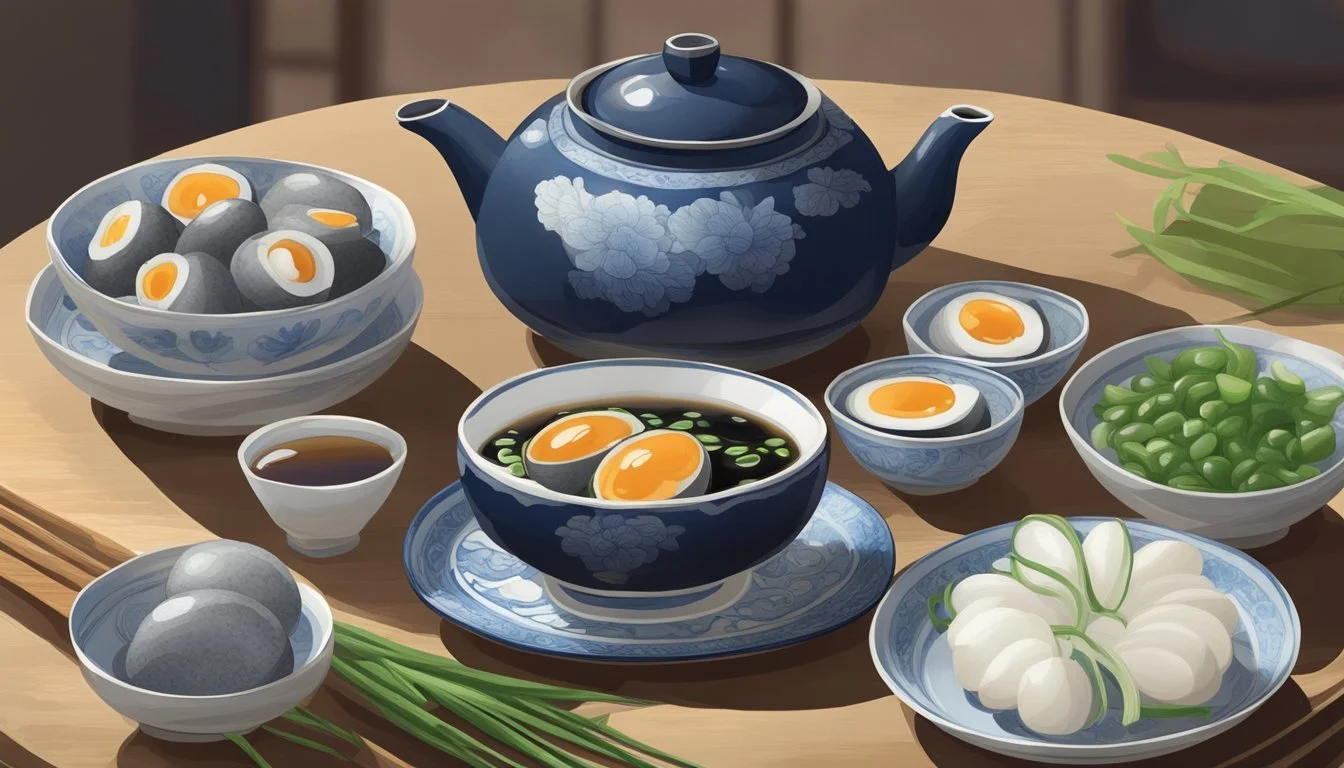Century Eggs Unveiling the Mystique of China's Unique Delicacy
Century eggs, a distinctive element of Chinese cuisine, are a preserved food known for their unusual flavor and appearance. They are traditionally made by curing duck, chicken, or quail (What wine goes well with quail?) eggs in a concoction of clay, ash, salt, quicklime, and rice hulls. Over several weeks or even months, this preservation process transforms the eggs’ texture and taste, resulting in a culinary product that contrasts greatly with the familiar fresh egg.
Often referred to as pidan in Chinese, these preserved eggs trace their history back centuries, with references to their preparation dating back to the Ming Dynasty. Their origins are somewhat shrouded in mystery, lending an additional layer of intrigue to the consumption of these eggs. Despite their name, century eggs do not actually age for a hundred years—rather, the name reflects the transformative effect of the preservation process.
Upon tasting a century egg, one would notice a creamy yolk and a gelatinous, firm egg white with a savory umami flavor and hints of smokiness. Unlike many Western preserved goods, these eggs are not sweet but rather offer a complex array of flavors that challenge and excite the palate. Century eggs stand as a testament to the rich culinary innovation and tradition that continues to thrive in Chinese culture.
Historical Background
Century eggs hold a distinctive place in Chinese culinary practices, reflecting a rich tradition deeply rooted in history.
Origins and Evolution of Century Eggs
The inception of century eggs, or pidan, is shrouded in lore, yet they are generally recognized as a Chinese delicacy with origins possibly harking back to the Ming Dynasty. They are the product of an age-old preservation technique that not only extends the shelf-life of eggs but also transforms their flavor and texture. This preservation involves a unique blend of materials such as clay, ash, salt, quicklime, and rice hulls, which cure the eggs over several weeks to months.
Ming Dynasty Influence
During the Ming Dynasty, between the 14th and 17th centuries, century eggs became particularly prominent. This era likely witnessed the refinement of the preservation process, elevating the status of century eggs to a staple within Chinese cuisine, appreciated for their distinctive taste and textural contrast. The Ming Dynasty contributed significantly to their cultural significance, embedding them within Chinese food (What wine goes well with Chinese food?) tradition and gastronomy.
What Are Century Eggs?
Century eggs are a unique delicacy, offering an unconventional flavor and texture that is testament to the ingenuity of traditional Chinese preservation methods.
Defining the Century Egg
A Century Egg refers to a traditional Chinese delicacy where eggs, typically from ducks, chickens, or quails, undergo a preservation process. This process involves encasing the eggs in a mixture of materials such as clay, ash, salt, quicklime, and rice hulls. Over several weeks or months, the eggs transform chemically, altering their color, texture, and flavor. The preserved egg gains a creamy, cheese-like yolk and a gelatinous, amber-colored white.
Comparing Century, Preserved, and Thousand-Year Eggs
Century Eggs, Preserved Eggs, and Thousand-Year Eggs are names that often refer to the same product, although the nomenclature may imply different aging times, they commonly denote the same type of preserved egg. Despite the name, the eggs are not preserved for a century or a millennium; the preservation period typically spans from several weeks to a few months. The process intensifies the egg's flavors and alters its proteins, creating a distinctive treat savored for its rich, savory umami taste.
Culinary Importance
Century eggs represent a significant element in Chinese cuisine, known for their distinctive flavor and appearance. Esteemed both as a stand-alone delicacy and as a component in various dishes, they have maintained their popularity over time.
Century Eggs in Chinese Cuisine
In Chinese gastronomy, century eggs are a beloved ingredient that add depth to a variety of recipes. They're considered a treat that showcases the sophistication of Chinese preserving techniques.
Notable aspects in Chinese Cuisine:
Cultural reverence: Century eggs are esteemed for their tradition and history.
Flavor enhancement: They impart a complex, creamy richness to dishes.
Textural contrast: Provides a gelatinous texture against softer foods like rice or tofu.
Popular Dishes Featuring Century Eggs
Some of the most popular dishes that incorporate century eggs are congee and various cold appetizers (What wine goes well with appetizers?).
Century Egg Congee (皮蛋瘦肉粥):
A rice porridge that combines the creamy, savory notes of the century egg with tender pork, often garnished with scallions and ginger to balance the rich flavors.
Century Egg: Flavor enhancer
Pork: Protein component
Rice: Base and thickener
Ginger: Aromatic and spice
Scallion: Freshness and color
Cold Tofu with Century Egg:
A refreshing dish where silken tofu's mild taste pairs excellently with the boldness of century egg slices, dressed with soy sauce and sesame oil.
Key elements in popular dishes:
Balance: Century eggs are balanced with more subtle flavors.
Variety: Used in both meat dishes and vegetarian options.
Versatility: Featured in both hot and cold recipes, showcasing their adaptability in Chinese cuisine.
Preservation and Preparation Techniques
Century eggs are a unique food item resulting from intricate preservation techniques that transform fresh eggs into a preserved delicacy with a distinctive flavor and texture. Two main methods, traditional and modern, ensure both the signature taste and safety of these eggs.
Traditional Preservation Methods
Traditionally, century eggs are produced using a mixture of natural ingredients that create an alkaline environment. Duck, chicken, or quail eggs are coated with a thick layer of a pasty mixture, which typically includes clay, ash, salt, quicklime, and rice hulls. These components trigger a chemical reaction that preserves the eggs.
Curing time: Several weeks to months
Texture changes: Whites become jelly-like; yolks turn creamy
Modern Methods for Safe Consumption
The modern preservation of century eggs leverages updated practices to ensure safety while maintaining the traditional flavor profile. Improvements include the use of controlled temperatures and pH levels to prevent contamination and the utilization of safer materials for the curing process.
Materials: Use of non-toxic quicklime and other harmless chemicals
Quality control: Regular checks for harmful bacteria
Preparing Century Eggs for Dishes
Preparing century eggs for consumption involves careful removal of the outer coating, followed by a rinse. Chefs typically slice or quarter the eggs to showcase their transformed interiors, adding them to a variety of dishes for their deep, complex flavors.
Slicing: Thin wedges or cubes exposed yolk and gelatinous white
Dishes: Commonly served with pickled ginger or in porridges and salads
Nutritional Profile
The nutritional composition of century eggs distinguishes them from regular eggs, primarily because of the preservation process. They are rich in protein and contain a variety of minerals that contribute to their health benefits.
Health Benefits of Century Eggs
Century eggs are a protein-packed food source and provide essential amino acids necessary for bodily functions. Protein is crucial for muscle repair and growth, making century eggs a favorable option for protein supplementation. In terms of minerals, century eggs supply notable amounts of calcium and iron, which support bone health and oxygen transportation in the bloodstream, respectively.
Calcium: Important for bones and teeth
Iron: Crucial for red blood cell function
Potential Risks and Misconceptions
Despite the health benefits, some individuals may have concerns about heavy metals in century eggs. However, if produced according to safety standards, century eggs should not pose a significant health risk. It is important to source century eggs from reputable producers to mitigate this concern.
A common misconception about century eggs is that they are extremely high in cholesterol or harmful additives, but this is often exaggerated. While moderation is key, as with all foods, the actual cholesterol content is not drastically different from regular eggs, and no harmful substances are present when following traditional and regulated preparation methods.
Flavor and Texture
Century eggs are notable for their distinct flavor and texture that set them apart from typical boiled or fried eggs. These attributes have been honed over centuries of traditional Chinese culinary practices.
Unique Flavor Characteristics
Century eggs possess a unique flavor profile that can be described as complex and multi-layered. They exhibit a strong savory taste, often associated with umami, which is the fifth basic taste characterized by a rich and meaty flavor. This is combined with an earthy quality, which adds depth to their overall flavor. Unlike ordinary eggs, century eggs do not have a sweet note, but rather a nuanced balance between their bold and savory aspects.
Texture Variation in Century Eggs
When discussing the texture of century eggs, one will note a pronounced difference from typical eggs. The egg white of a century egg has a firm, jelly-like consistency reminiscent of a gelatine-based dessert. It contrasts strikingly with the creamy texture of the yolk, which is softer and possesses a cheese-like quality. The distinction in texture between the egg's two components provides an interesting sensory experience when consumed.
Cultural and Social Perspectives
Century eggs hold a distinctive place in Chinese culture, representing both traditional practices and the evolving palette of global cuisine. Their unique flavor profile and preparation method position them as a culinary marker of cultural heritage and a subject of international curiosity.
Century Eggs as a Cultural Symbol
In Chinese culture, century eggs embody a rich heritage of culinary tradition. They are often associated with festive occasions and are served in various dishes during celebrations to symbolize prosperity and are a staple at festive events like the Lunar New Year. The preservation technique for century eggs is time-honored, passed down through generations, and reflects an innovative approach to extending the shelf-life of a basic food commodity. These eggs signify not just sustenance but also the ingenuity of ancient Chinese food preservation methods.
Acquired Taste and Global Reception
Century eggs are an acquired taste due to their potent flavor and unusual appearance. To those unfamiliar with this delicacy, the initial encounter can be quite striking, as the eggs exhibit a darkened color and a strong, pungent aroma. However, they are celebrated by connoisseurs and adventurous eaters, who appreciate the depth of flavor and the unique texture they contribute to dishes. As Chinese cuisine gains popularity worldwide, the global reception of century eggs is increasingly marked by intrigue and a growing acceptance, reflecting the expanding palate for traditional foods within international communities.
Innovative Century Egg Recipes
Century eggs, with their complex flavors, offer an exquisite twist to modern dishes. They are incorporated into both traditional and contemporary cuisines, enhancing meals with their distinctive taste.
Fusion Cuisine and Century Eggs
Fusion dishes celebrate the combination of diverse culinary traditions. Chefs have started to integrate century eggs into a variety of cuisines with eye-catching results.
Century Egg and Avocado Toast: A layer of mashed avocado, topped with thin slices of century egg, drizzled with sesame oil and sprinkled with sesame seeds for a cross-cultural brunch item.
Asian-Style Century Egg Salad: Mixed greens tossed with wedge-cut century eggs, drizzled with a soy-sesame dressing, adding umami flavor to a simple salad.
These innovations not only honor the past but also embrace the evolving palate of diners around the world.
Homemade Century Egg Delicacies
Home cooks are equally inventive with century eggs, crafting dishes that can serve as snacks, appetizers, or part of a larger meal.
Century Egg Dumplings: Incorporate finely chopped century eggs into the dumpling filling for a surprise burst of flavor that complements pork or shrimp fillings.
Century Egg Tofu Appetizer: Cold silken tofu topped with diced century eggs, a dash of soy sauce, and a sprinkling of chopped green onions, (What wine goes well with onions?) creating a refreshing and savory appetizer.
By experimenting with century eggs at home, cooks can add a unique spin to everyday cooking, transforming regular dishes into conversation starters.
Navigating Concerns and Controversies
As century eggs gain popularity worldwide, it's important to address the health and safety issues that have arisen, as well as to debunk common myths that persist about this unique delicacy.
Addressing Health and Safety Issues
Safety of Preservation Methods: The traditional method of producing century eggs involves coating eggs in a mixture of materials, including clay, ash, salt, quicklime, and rice hulls for several weeks or months. While this method is generally safe, concerns have been raised over the potential introduction of toxic substances during the preservation process.
Chemicals: In some cases, industrial chemicals have been used illegally to speed up production, leading to safety concerns regarding contamination with hazardous substances like heavy metals. Legal manufacturing standards prohibit such practices, ensuring that the eggs are free from harmful levels of chemicals and metals like lead.
Bacteria: The preservation process is designed to inhibit the growth of bacteria that could spoil the eggs or pose health risks. Properly preserved century eggs are safe to consume when the industry's safety protocols are followed.
Debunking Myths Surrounding Century Eggs
Misconception About Toxicity: A common myth about century eggs is that they are inherently toxic due to their strong odor and significant transformation during the curing process. However, this transformation is a controlled reaction that does not introduce toxins but rather develops the eggs' unique flavors and textures.
Lead Content: Concerns about the presence of lead in century eggs can often be traced back to instances where non-approved methods have been used. It's crucial to source century eggs from reputable producers who adhere to strict food safety regulations.
Bacterial Hazards: Another myth is the potential for bacterial contamination such as botulism. But, proper modern preservation techniques ensure safety, preventing harmful bacterial growth.
Serving and Pairing Suggestions
When enjoying Century Eggs, the selection of complements can greatly enhance their unique taste. The right condiments can balance the strong flavors, while suitable beverages can cleanse the palate between bites.
Ideal Condiments and Accompaniments
Century Eggs can be served with a variety of condiments and side dishes that enhance their flavor:
Soy Sauce: A few drops of soy sauce can bring out the umami flavors of the eggs.
Vinegar: Mild vinegar balances the richness with its acidity.
Sesame Oil: A delicate drizzle of sesame oil adds a fragrant nuttiness.
Ginger: Fresh ginger offers a sharp, spicy contrast to the egg's creaminess.
Accompaniments that pair well with Century Eggs include:
Congee: This rice porridge allows the flavors of the preserved egg to shine through without overwhelming.
Soup: A clear, delicate broth offsets the century egg’s intense flavor.
Rice: Steamed rice provides a neutral backdrop, letting the egg's complex taste be the focal point.
Beverage Pairings
Choosing the right beverage to accompany Century Eggs can enhance the overall dining experience. Here are some recommended pairings:
Tea: Milder teas, like green tea, can cleanse the palate and provide a refreshing counterbalance to the egg's richness.
Soup Broth: A warm, flavorful broth complements the depth of flavor found in Century Eggs.
Conclusion
Century eggs, with their unique flavor profile and textural contrast, stand as a testament to the ingenuity of traditional Chinese cuisine. Misconceptions about their pungency often overshadow the culinary versatility they offer. This section aims to demystify the preserved eggs and speculate on their role in future food cultures.
Century Eggs: Beyond the Pungency
Despite the initial surprise to the unaccustomed palate, century eggs possess a nuanced flavor that can enrich various dishes. The unique preservation process imparts an earthy, complex taste that is often accompanied by subtle hints of ammonia which should not be mistaken for spoilage. The blend of firm egg whites and creamy yolks offers a textural contrast appreciated in various Asian culinary applications. As dining preferences evolve, so might the appreciation for the sophisticated taste of century eggs.
Future of Century Eggs in Global Cuisine
The allure of century eggs has piqued interest beyond their traditional sphere, hinting at a promising future within global cuisine. Their robust umami flavor can complement a wide range of ingredients, hinting at their potential inclusion in contemporary recipes. As global palates become ever more adventurous, century eggs may transition from ethnic delicatessens to mainstream gastronomy, redefining their role as a versatile component in the culinary arts.









